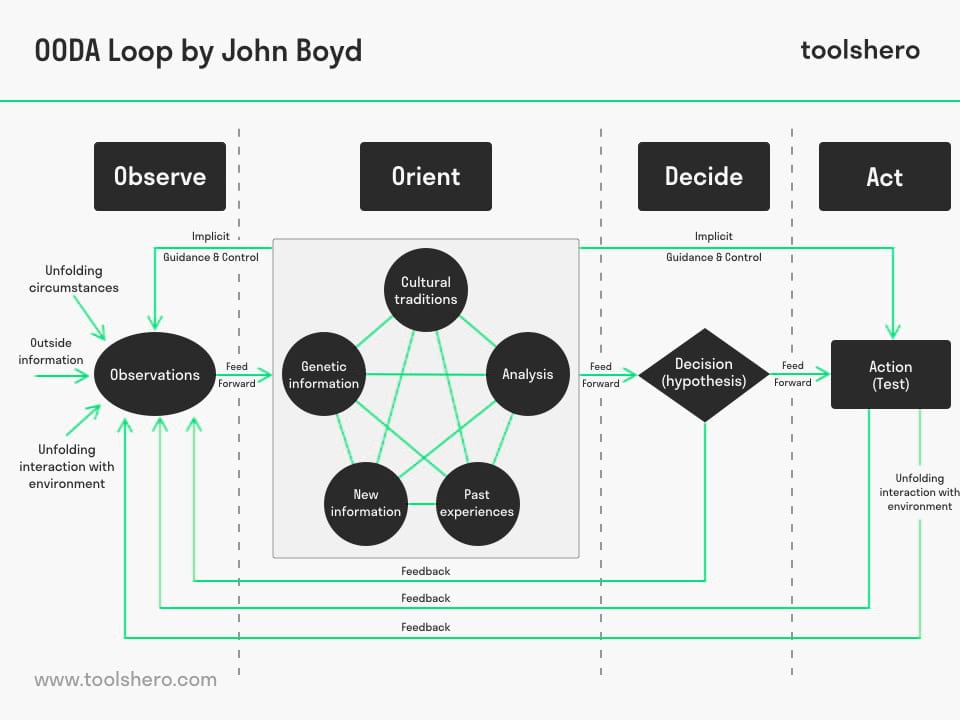OODA Loop by John Boyd explained

OODA Loop process: this article describes the concept of the OODA Loop process, developed by John Boyd in a practical way. Next to what it is (meaning and theory), this article highlights the improatcne of interaction with environment, the OODA Loop process diagram and the disadvantages. After reading you will understand the basics of this decision making process theory. Enjoy reading!
What is an OODA Loop?
Colonel John Boyd developed the OODA Loop based on his experiences as a fighter pilot during the Korean War and later as an instructor.
The OODA loop is the cycle observe–orient–decide–act, developed by military strategist and United States Air Force Colonel John Boyd. He gained a lot of experience in the militairy, first as a fighter pilot during the Korean War and later as an instructor.
This decision making process consists of Observe, Orient, Decide and Act. It is a cyclical model, that is used in military strategy, but also in law enforcement and business.
By using this loop you are able to continuously adapt to changing circumstances and use this to draw on your strengths in order to win in competitive environments.
In aerial combat, reaction time and split-second decisions and actions are crucial. When response times are too slow, the enemy gets the upper hand. We live in a rapidly changing world. If you do not change with the times, chances are that you will go under.
Interaction with environment
John Boyd developed OODA from this key concept. This is the process in which an individual or organization responds to an event, where situational awareness is key. By responding quickly to situations and taking appropriate decisions faster, you can get ahead of your opponent’s decision cycle.
He assumed that intelligent organisms and organizations are in constant interaction with their environment.
According to him, it causes complexity in an organization when managers and employees become prisoners of their own views. An organization can only survive if it breaks through this impasse by adapting itself to changing external conditions.
The OODA Loop process diagram explained

Figure 1 – OODA Loop Process diagram (Boyd)
In the OODA Loop process diagram, John Boyd divided this decision-making process into four interacting and overlapping main processes:
1. Observe
By understanding quickly what is going on, you can observe the changing situation clearly. You will have to look at yourself and the situation as though you were an outsider and not from your own point of view. All senses are used at this stage, as a result of which as much information can be collected as practically possible.
2. Orient
At the orientation step you will know what has to be done. This does not only concern position, but also the possible options you can visualize.
John Boyd distinguishes the following factors that play an important role in this stage including genetic inheritance, cultural traditions, past experiences, analysis and new information.
Orientation does not only indicate how you see the world, but also what kind of world you are capable of seeing. The orientation stage is described as the most important process in the loop. The information from step 1 is organized.
3. Decide
This stage is about learning from experiences. Based on someone’s current mental perspective, they make decisions and determine what course of action they need to take. The right decision is taken and actions follow from this.
4. Action
The physical execution of the decision is a fact at this stage. The selected approach is actually carried out.
Experiences and/ or consequences of the approach are forwarded to the first stage, observe, after which the loop is complete and the cycle starts over again. It is a very quick process.
The objective is that a potential opponent’s OODA Loop does not get the chance to be completed as well, so that the opponent always keeps running behind the facts. The combination of observation and orientation leads to a decision which in turn leads to action. And then the cycle starts over again.
It is a continuous process in which you should always be on the alert in a changing environment. When there is an equilibrium state, there is little chance of survival.
Disadvantages of the loop
As a military strategist, John Boyd didn’t confine himself to any particular discipline and his theories encompass ideas drawn from various disciplines, including mathematical logic, biology, psychology, thermodynamics, game theory, anthropology, and physics.
Unfortunately, Boyd never wrote down his ideas on his OODA model in articles or a book, but he mentioned them in his presentations. This is why there are various interpretations of this model. Although the model is detailed and widely used, it does have certain disadvantages:
- The model skips ‘memory’. When a situation has occurred before, the wheel does not have to be reinvented all over again by going through the loop again.
- The model has not been tested scientifically, so there is no proof that the loop is correct.
- The model does not incorporate an opponent, although we have to reckon with opponents by being faster than they are.
- The model does not include the factor ‘cooperation’ and is based too much on gunfights. By working with teams in accordance with the OODA model, a new outcome is created. Other factors then also come into play, including negotiation, task allocation, hierarchy, human behaviour, motivation, and so on. These are all factors that affect the decision-making process.
OODA Loop video (in-depth explainer)
Watch the in-depth video below for a recap of what you’ve just read, so you will remember it more easily!
It’s Your Turn
What do you think? Is the OODA model applicable in today’s modern business and personal challenges? Do you recognize the practical explanation or do you have more suggestions? What are your success factors for a good decision making process?
Share your experience and knowledge in the comments box below.
More information
- Brehmer, B. (2005, June). The dynamic OODA loop: Amalgamating Boyd’s OODA loop and the cybernetic approach to command and control. In Proceedings of the 10th international command and control research technology symposium (pp. 365-368).
- Boyd, J. R. (1996). The essence of winning and losing. Unpublished lecture notes, 12(23), 123-125.
- Ford, D. (2010). A Vision So Noble: John Boyd, the Ooda Loop, and America’s War on Terror. Daniel Ford.
- Ullman, D. G. (2006). Making robust decisions: decision management for technical, business, and service teams. Trafford on Demand Pub.
How to cite this article:
Mulder, P. (2017). OODA Loop (Boyd). Retrieved [insert date] from Toolshero: https://www.toolshero.com/decision-making/ooda-loop/
Original publication date: 06/11/2017 | Last update: 02/28/2024
Add a link to this page on your website:
<a href=”https://www.toolshero.com/decision-making/ooda-loop/”>Toolshero: OODA Loop (Boyd)</a>













4 responses to “OODA Loop by John Boyd explained”
The disadvantages discussed reveal a superficial understanding of John Boyd’s work and the OODA loop concept itself.
1. “Orient”, in fact, refers to the collective, shared memory of a person within an institution. Orient refers to a sort of “muscle memory” for decision making that unconsciously impacts all of us. In the group setting, it’s the institutional memory embedded in how we train and incentivize our people.
2. I’m not sure how one would test this scientifically, exactly, but it maps well to other time tested processes such as the Scientific Method and PDCA cycle. Are those “scientifically proven”? It also maps well to System I and System II thinking–the inside and outside OODA loops–well documented in cognitive science and psychology (See Daniel Kahneman, “Thinking Fast & Slow”.
3. OODA Loop is exactly and precisely about dealing with an opponent in a conflict–this is the domain that John Boyd had in mind when creating model. The Observation step is grasping the unfolding circumstances and environment inflicted on you by the opponent. The feedback loops are about adjusting your mental models based on your observations of how the opponent changed the environment.
4. OODA Loop has a great deal to say about cooperation in groups large and small. Boyd’s domain was warfare, where large groups of soldiers have to make rapid, independent decisions toward common goals under extreme stress and uncertainty. Much of what Boyd had to say about cooperation lay in the idea of creating a common orientation between different members of a team. And this orientation comes from shared experiences, usually built through training and story telling. Orientation is deliberately embedded in the center of the loop.
While it’s true that John Boyd himself did not publish his own thoughts on the OODA loop, there are several books and countless articles by his various apprentices and friends, and others who have followed in his footsteps.
Andy, it has been a few years since you made your comments. I fully agree that Patty’s assessment on the disadvantages of Boyd’s OODA loop is based on a surface understanding of the concepts. Particularly, Orientation includes past experience and cultural heritage (thus, memory), and the Implicit Guidance and control can also include past and repetitive experience in decision making. In fact, engaging in the environment produces new knowledge about what impact your decisions and actions had on the outside world. I believe that the “disadvantages” mentioned here completely missed the boat.
Thank you for your comment, Gregory.
I use OODA to teach children ( 12 to 18 yrs old ) how to respond in a high stress situation such as an earthquake, fire, or active assailant event where the situation could change instantly. I would run fire drills before and after introducing them to OODA. After training with OODA there was a marked reduction in ‘information overload and freeze’ episodes. It simply works!